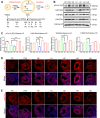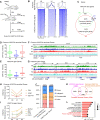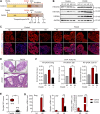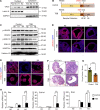Ovulatory signal-triggered chromatin remodeling in ovarian granulosa cells by HDAC2 phosphorylation activation-mediated histone deacetylation
- PMID: 37076890
- PMCID: PMC10116676
- DOI: 10.1186/s13072-023-00485-8
Ovulatory signal-triggered chromatin remodeling in ovarian granulosa cells by HDAC2 phosphorylation activation-mediated histone deacetylation
Abstract
Background: Epigenetic reprogramming is involved in luteinizing hormone (LH)-induced ovulation; however, the underlying mechanisms are largely unknown.
Results: We here observed a rapid histone deacetylation process between two waves of active transcription mediated by the follicle-stimulating hormone (FSH) and the LH congener human chorionic gonadotropin (hCG), respectively. Analysis of the genome-wide H3K27Ac distribution in hCG-treated granulosa cells revealed that a rapid wave of genome-wide histone deacetylation remodels the chromatin, followed by the establishment of specific histone acetylation for ovulation. HDAC2 phosphorylation activation coincides with histone deacetylation in mouse preovulatory follicles. When HDAC2 was silenced or inhibited, histone acetylation was retained, leading to reduced gene transcription, retarded cumulus expansion, and ovulation defect. HDAC2 phosphorylation was associated with CK2α nuclear translocation, and inhibition of CK2α attenuated HDAC2 phosphorylation, retarded H3K27 deacetylation, and inactivated the ERK1/2 signaling cascade.
Conclusions: This study demonstrates that the ovulatory signal erases histone acetylation through activation of CK2α-mediated HDAC2 phosphorylation in granulosa cells, which is an essential prerequisite for subsequent successful ovulation.
Keywords: Chromatin remodeling; Granulosa cells; H3K27Ac; HDAC2; Luteinizing hormone; Ovulation.
© 2023. The Author(s).
Conflict of interest statement
The authors declare no competing interests.
Figures







Similar articles
-
Testosterone-Induced H3K27 Deacetylation Participates in Granulosa Cell Proliferation Suppression and Pathogenesis of Polycystic Ovary Syndrome.Am J Pathol. 2024 Dec;194(12):2326-2340. doi: 10.1016/j.ajpath.2024.08.012. Epub 2024 Sep 5. Am J Pathol. 2024. PMID: 39243944
-
CBP-CITED4 is required for luteinizing hormone-triggered target gene expression during ovulation.Mol Hum Reprod. 2014 Sep;20(9):850-60. doi: 10.1093/molehr/gau040. Epub 2014 May 30. Mol Hum Reprod. 2014. PMID: 24878634 Free PMC article.
-
Integrated Analysis of Transcriptome and Histone Modifications in Granulosa Cells During Ovulation in Female Mice.Endocrinology. 2021 Sep 1;162(9):bqab128. doi: 10.1210/endocr/bqab128. Endocrinology. 2021. PMID: 34171084
-
Ovulation as a tissue remodelling process. Proteolysis and cumulus expansion.Adv Exp Med Biol. 1995;377:121-40. doi: 10.1007/978-1-4899-0952-7_8. Adv Exp Med Biol. 1995. PMID: 7484419 Review.
-
ERβ Regulation of Gonadotropin Responses during Folliculogenesis.Int J Mol Sci. 2021 Sep 26;22(19):10348. doi: 10.3390/ijms221910348. Int J Mol Sci. 2021. PMID: 34638689 Free PMC article. Review.
Cited by
-
Mechanism of crosstalk between DNA methylation and histone acetylation and related advances in diagnosis and treatment of premature ovarian failure.Epigenetics. 2025 Dec;20(1):2528563. doi: 10.1080/15592294.2025.2528563. Epub 2025 Jul 7. Epigenetics. 2025. PMID: 40620015 Free PMC article. Review.
-
Cellular atlas of the human ovary using morphologically guided spatial transcriptomics and single-cell sequencing.Sci Adv. 2024 Apr 5;10(14):eadm7506. doi: 10.1126/sciadv.adm7506. Epub 2024 Apr 5. Sci Adv. 2024. PMID: 38578993 Free PMC article.
-
The roles of MAPK signaling pathway in ovarian folliculogenesis.J Ovarian Res. 2025 Jul 14;18(1):152. doi: 10.1186/s13048-025-01737-9. J Ovarian Res. 2025. PMID: 40660328 Free PMC article. Review.
References
-
- Richards JS, Jahnsen T, Hedin L, Lifka J, Ratoosh S, Durica JM, Goldring NB. Ovarian follicular development: from physiology to molecular biology. Recent Prog Horm Res. 1987;43:231–276. - PubMed
-
- Park JY, Su YQ, Ariga M, Law E, Jin SL, Conti M: EGF-like growth factors as mediators of LH action in the ovulatory follicle. Science (80- ) 2004, 303(5658):682–684. - PubMed
Publication types
MeSH terms
Substances
LinkOut - more resources
Full Text Sources
Molecular Biology Databases
Miscellaneous

